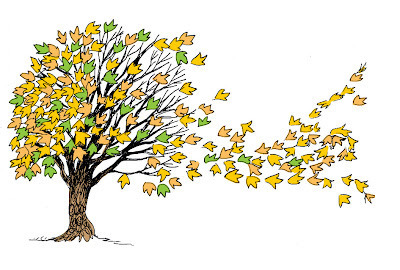John Shelley's Blog, page 14
October 9, 2012
John and the Beanstalk (feature for Ano Ne Magazine)
I’ve been fascinated by fairy tales and fairy lore for as long as I can remember. Far more than contemporary fiction, as a child it was the tales of Grimm, Arabian Nights and Hans Andersen that really gripped my imagination. My mother had several old collected editions of these tales dating from her own childhood which she only produced at bedtime to read to us. With their classic Golden Age illustrations those books were for me hallowed tomes, things to be held in reverence which inspired my eventual path as an illustrator.
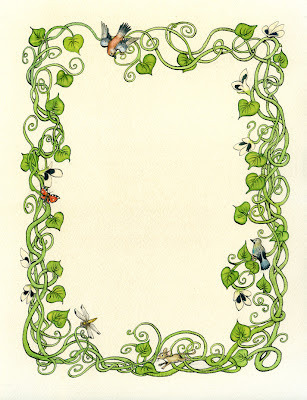
Jack and the Beanstalk Title Page border design
When Fukuinkan Shoten approached me to select and illustrate a classic English fairy tale I delved deep into research and initially proposed some rare tales that have yet to be adapted into picture books, however after discussion with my editor we eventually settled on the exuberant tale of Jack and the Beanstalk , as there is no 'default edition' of this story as a picture book in Japan. Fukuinkan wished to produce a classic, traditionally retold and illustrated version that will become the benchmark interpretation in Japanese.
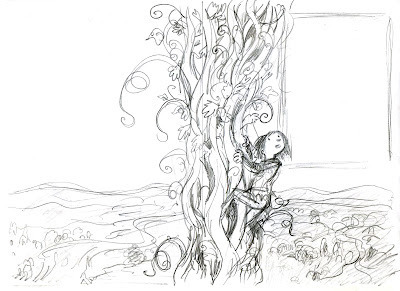
Pencil sketch for the cover design
Jack and the Beanstalk has everything - magic, a mysterious stranger, ogres, a cloud world, and is packed with dramatic crescendos which would be a joy to illustrate. But more than this, the tale of Jack poses numerous unresolved questions both about Jack and of the land above the clouds, and the more I analysed these thematic conundrums the more fascinating the story became. To explore these aspects and offer solutions was both a challenge and a great pleasure.
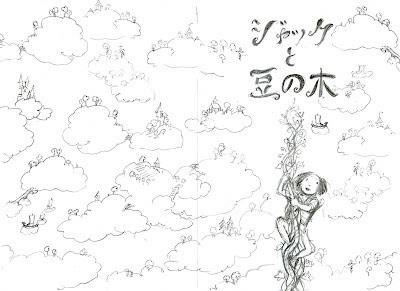
Alternative variation for cover design (unused)
Jack and the Beanstalk is an ancient story passed down orally by storytellers from generation to generation. Partial elements from early versions have been recorded from at least as far back as the 17th Century and there are several variations, however the tale popular today has derived from two printed versions, a somewhat dogmatic adaptation by Benjamin Tabart published in 1807, later retold by Andrew Lang, and a more robust rendering later in the nineteenth century by Joseph Jacobs.
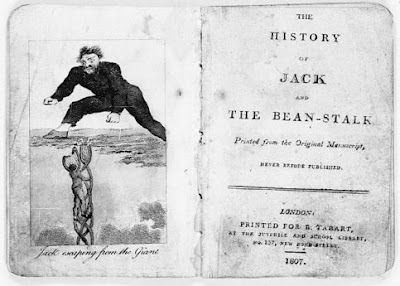
Tabart's 1807 edition of Jack, the first known printing of the story known today
I based my re-telling on Jacobs’s version which is regarded as the one that’s closest to the oral traditions, and with the most energy and directness, although it lacks a redeeming motive for Jack’s repeated raids up the beanstalk. Jack is unashamedly a thief, the reader is almost tempted to feel pity for the ogre and his accomplice wife. In Tabart’s version of the story Jack is given an excuse to punish the ogre, as the house in the sky is said to have once belonged to Jack’s father, who was killed by the ogre and Jack and his mother reduced to destitution. Though such a plot tidily wraps up certain aspects of the story it's a more laboured and moralising version. Overall then I chose to allow Jack to be a plucky scoundrel, I believe the ambiguity of his morality adds greatly to the story. Readers question Jack as much as the ogre.
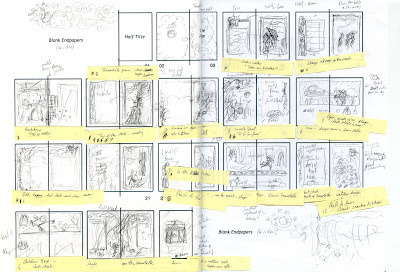
Initial storyboard based on a 32-page format. The book eventually stretched to 44 pages.
Once I began on the illustrations other questions immediately demanded analysis. Who is the mysterious stranger who gives Jack the beans? What does he want with the old cow? Is it simply an excuse to give the beans to Jack? It seems Jack has been chosen to ascend the beanstalk, but why? And what happens to the cow thereafter? These are questions that almost require another book to explore, and I felt it best left unresolved in the text. The illustrations however could perhaps provide a few hints as to the fate of the cow and the connection of the strange man with Jack.
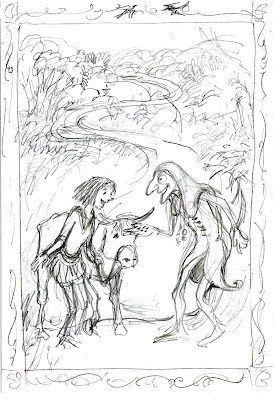
Jack meets the Stranger. First rough pencil sketch.
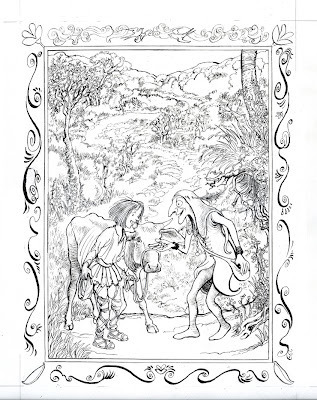
Pen and ink artwork before colouring
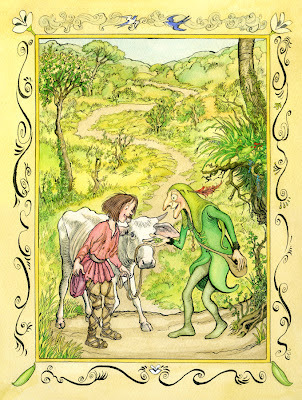
The final completed illustration
In the illustrations I tried to add details that make it as believable as possible. Although the story is a fantasy it has to be a logical world, so I began asking myself more questions. Accepting the absurdity that clouds can support a magical world in the first place, I wondered, does the ogre and his wife inhabit the cloud-world alone, or are there other houses, other inhabitants? As the clouds drift apart how do they get around? The ogre devours children and cattle, but from where does he get them? Above the clouds? Or does he have a way to descend to earth to prey on the people below? He obviously has a particular dislike of ‘Englishmen’.
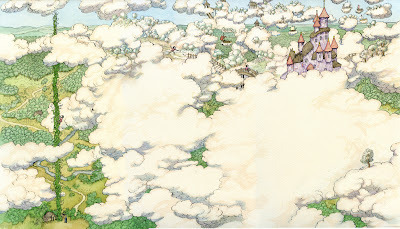
Jack arrives in the cloud world
If the clouds can magically support fields and buildings then they would certainly support sailing boats too, and one thing there is plenty of in the sky is wind power! So in my world the clouds are islands of structures, settlements, fields and trees, connected by sky boats powered by wind, kept aloft on wisps of cloud. The ogre would have his own vessel to go hunting above and below the clouds.
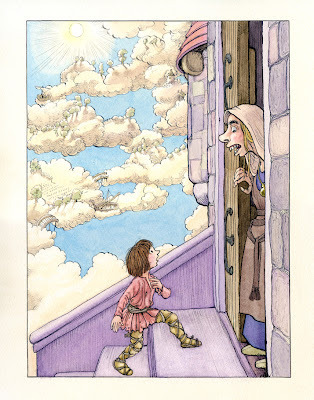
Jack meets the Ogre's wife, vistas of cloud-land beyond
In addition to children and cattle one thing he almost certainly would come across all the time is birds! These would be like snacks for a hungry ogre, and so the kitchen has lots of birds and bird-cages. Considering the mechanics of the ogre’s realm enriches the fantasy of the story, there are connections with flying creatures throughout the book.
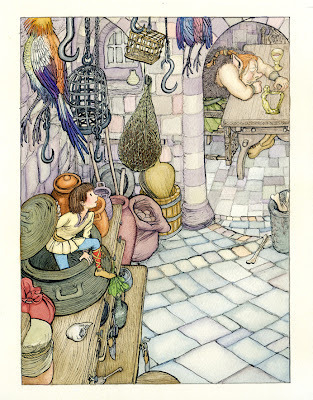
The Ogre's kitchen, with bird cages and feathered snacks
Another theme is the historical setting. I based the story in the period known as the Dark Ages in Britain, the time after the departure of the Roman Empire up to the Norman conquest. Around the 6th century AD the land was overrun by tribes of Angles (from southern Denmark) and Saxons (from Germany) - hence Anglo-Saxon - while the original inhabitants were gradually pushed to the far corners of the country. Folklorists have theorised that some stories of fairies and other creatures have their origins in tales told by Anglo-Saxons about the mysterious and secretive original tribes of the land - the Britons. My ogre then is a vestige of the older, defeated culture, and thus distinctly "Celtic" in dress and manner, whereas Jack and his mother are Anglo-Saxon.
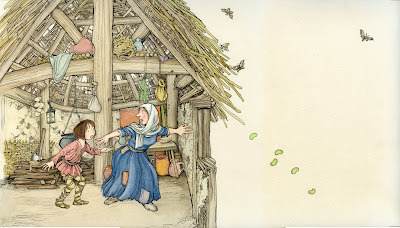
Jack argues with his mother over the beans
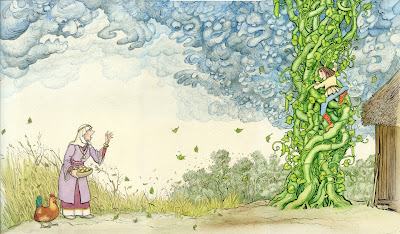
Rags to riches thanks to the golden eggs, but still Jack seeks more
The struggle between Jack and the ogre is not only one of boy versus monster, but also a clash of cultures, of ancient races versus new invaders. This, then, is why the ogre hates “Englishmen” so much!
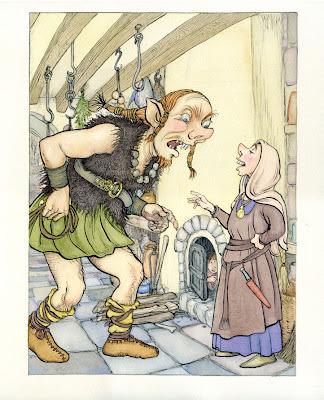
The 'Celtic' Ogre and his Wife
Then consider the ogre’s wife. Though a tall woman she’s not an ogre herself, yet she’s happily married to one. She doesn’t seem a particularly evil character, but is nevertheless willing to chop up and cook children for her husband’s dinner! What becomes of her after her husband’s demise is never explained in the old tales, however I imagine she comes off quite well in the end - she keeps the great house, and is free of the ogre, who could not have been the easiest of partners.
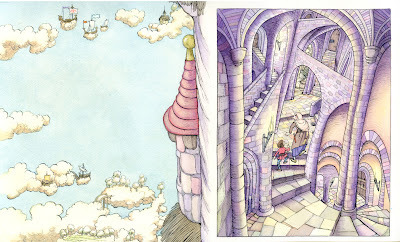
Inside the Ogres house
Historically Jack himself is almost certainly related to that other great “Jack” in English fairy tales - Jack the Giant Killer , another tale I’m very fond of, and currently the subject of an upcoming Hollywood movie, though it’s a sad story of violent persecution from the point of view of the endangered giants! The two fairy tales have much in common, in some versions of Jack and the Beanstalk the ogre shares a name (Blunderbore) with a giant in the other tale. All these stories probably come from the same group of orally related tales, condensed and honed over many years to the stories we know today. And yet there is one big difference often overlooked (and certainly missed by Hollywood) - In the Beanstalk tale Jack is faced by an Ogre , not a Giant - there is a clear difference. Ogres are always man-eaters, the definition of an ogre is that they eat people. They're often hideously ugly and although sometimes big, they're not as big as giants! On the other hand Giants are often portrayed in the old tales as simply very large men, slow-witted, covetous, destructive and occasionally murderous perhaps but not usually cannibalistic.
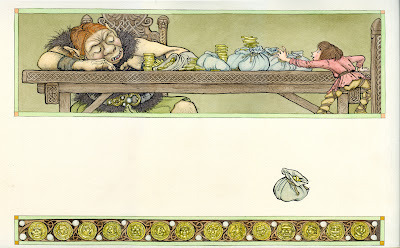
Jack steals the money bag. Note the size comparison! The coins are headed with Ogre kings.
We have only to consider the items stolen by Jack to confirm this: bags of money, the golden egg laying chicken, and finally the harp - if these were 'giant sized' Jack would not be able to carry them. If on the other hand they were 'human sized' they would be too small for a Giant to worry about. So definitely, not a giant, but a large ogre. Hollywood take note!
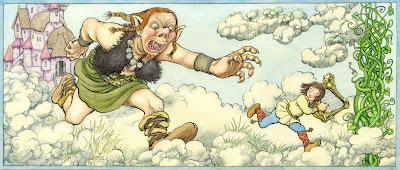
The Ogre in pursuit of Jack
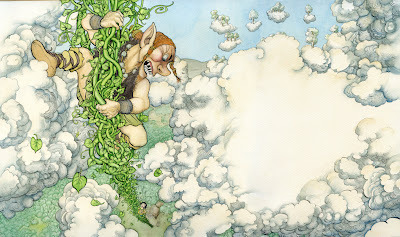
Right behind you Jack
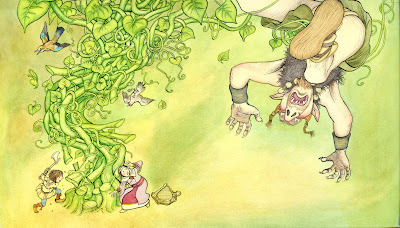
Calamity!
Unusually for fairy tales Jack does not marry a Princess after his return, but instead goes into business with his mother touring their treasures around the country. I really like that idea, it gives the story an earthy realism after the fantasy of the ogre. They become rich, and live happily, they need no more than that. I’m still wondering about the green man who bought the cow though, what happened to the two of them? Perhaps the ogre’s wife knows something, but she’s not telling....!
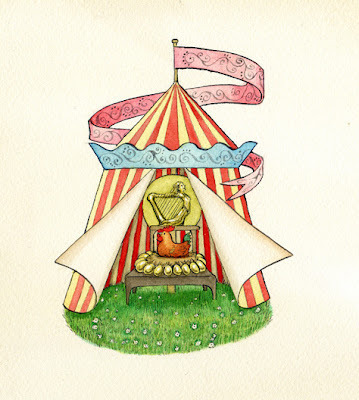
Final page image
(This post is the English-language transcription of a feature I put together for the October 2012 issue of Ano Ne magazine in Japan.)
Jack to Mame no Ki (Jack and the Beanstalk) retold & illustrated by yours truely and translated by Yuko Obika, is available internationally from Amazon Japan.

Jack and the Beanstalk Title Page border design
When Fukuinkan Shoten approached me to select and illustrate a classic English fairy tale I delved deep into research and initially proposed some rare tales that have yet to be adapted into picture books, however after discussion with my editor we eventually settled on the exuberant tale of Jack and the Beanstalk , as there is no 'default edition' of this story as a picture book in Japan. Fukuinkan wished to produce a classic, traditionally retold and illustrated version that will become the benchmark interpretation in Japanese.

Pencil sketch for the cover design
Jack and the Beanstalk has everything - magic, a mysterious stranger, ogres, a cloud world, and is packed with dramatic crescendos which would be a joy to illustrate. But more than this, the tale of Jack poses numerous unresolved questions both about Jack and of the land above the clouds, and the more I analysed these thematic conundrums the more fascinating the story became. To explore these aspects and offer solutions was both a challenge and a great pleasure.

Alternative variation for cover design (unused)
Jack and the Beanstalk is an ancient story passed down orally by storytellers from generation to generation. Partial elements from early versions have been recorded from at least as far back as the 17th Century and there are several variations, however the tale popular today has derived from two printed versions, a somewhat dogmatic adaptation by Benjamin Tabart published in 1807, later retold by Andrew Lang, and a more robust rendering later in the nineteenth century by Joseph Jacobs.

Tabart's 1807 edition of Jack, the first known printing of the story known today
I based my re-telling on Jacobs’s version which is regarded as the one that’s closest to the oral traditions, and with the most energy and directness, although it lacks a redeeming motive for Jack’s repeated raids up the beanstalk. Jack is unashamedly a thief, the reader is almost tempted to feel pity for the ogre and his accomplice wife. In Tabart’s version of the story Jack is given an excuse to punish the ogre, as the house in the sky is said to have once belonged to Jack’s father, who was killed by the ogre and Jack and his mother reduced to destitution. Though such a plot tidily wraps up certain aspects of the story it's a more laboured and moralising version. Overall then I chose to allow Jack to be a plucky scoundrel, I believe the ambiguity of his morality adds greatly to the story. Readers question Jack as much as the ogre.

Initial storyboard based on a 32-page format. The book eventually stretched to 44 pages.
Once I began on the illustrations other questions immediately demanded analysis. Who is the mysterious stranger who gives Jack the beans? What does he want with the old cow? Is it simply an excuse to give the beans to Jack? It seems Jack has been chosen to ascend the beanstalk, but why? And what happens to the cow thereafter? These are questions that almost require another book to explore, and I felt it best left unresolved in the text. The illustrations however could perhaps provide a few hints as to the fate of the cow and the connection of the strange man with Jack.

Jack meets the Stranger. First rough pencil sketch.

Pen and ink artwork before colouring

The final completed illustration
In the illustrations I tried to add details that make it as believable as possible. Although the story is a fantasy it has to be a logical world, so I began asking myself more questions. Accepting the absurdity that clouds can support a magical world in the first place, I wondered, does the ogre and his wife inhabit the cloud-world alone, or are there other houses, other inhabitants? As the clouds drift apart how do they get around? The ogre devours children and cattle, but from where does he get them? Above the clouds? Or does he have a way to descend to earth to prey on the people below? He obviously has a particular dislike of ‘Englishmen’.

Jack arrives in the cloud world
If the clouds can magically support fields and buildings then they would certainly support sailing boats too, and one thing there is plenty of in the sky is wind power! So in my world the clouds are islands of structures, settlements, fields and trees, connected by sky boats powered by wind, kept aloft on wisps of cloud. The ogre would have his own vessel to go hunting above and below the clouds.

Jack meets the Ogre's wife, vistas of cloud-land beyond
In addition to children and cattle one thing he almost certainly would come across all the time is birds! These would be like snacks for a hungry ogre, and so the kitchen has lots of birds and bird-cages. Considering the mechanics of the ogre’s realm enriches the fantasy of the story, there are connections with flying creatures throughout the book.

The Ogre's kitchen, with bird cages and feathered snacks
Another theme is the historical setting. I based the story in the period known as the Dark Ages in Britain, the time after the departure of the Roman Empire up to the Norman conquest. Around the 6th century AD the land was overrun by tribes of Angles (from southern Denmark) and Saxons (from Germany) - hence Anglo-Saxon - while the original inhabitants were gradually pushed to the far corners of the country. Folklorists have theorised that some stories of fairies and other creatures have their origins in tales told by Anglo-Saxons about the mysterious and secretive original tribes of the land - the Britons. My ogre then is a vestige of the older, defeated culture, and thus distinctly "Celtic" in dress and manner, whereas Jack and his mother are Anglo-Saxon.

Jack argues with his mother over the beans

Rags to riches thanks to the golden eggs, but still Jack seeks more
The struggle between Jack and the ogre is not only one of boy versus monster, but also a clash of cultures, of ancient races versus new invaders. This, then, is why the ogre hates “Englishmen” so much!

The 'Celtic' Ogre and his Wife
Then consider the ogre’s wife. Though a tall woman she’s not an ogre herself, yet she’s happily married to one. She doesn’t seem a particularly evil character, but is nevertheless willing to chop up and cook children for her husband’s dinner! What becomes of her after her husband’s demise is never explained in the old tales, however I imagine she comes off quite well in the end - she keeps the great house, and is free of the ogre, who could not have been the easiest of partners.

Inside the Ogres house
Historically Jack himself is almost certainly related to that other great “Jack” in English fairy tales - Jack the Giant Killer , another tale I’m very fond of, and currently the subject of an upcoming Hollywood movie, though it’s a sad story of violent persecution from the point of view of the endangered giants! The two fairy tales have much in common, in some versions of Jack and the Beanstalk the ogre shares a name (Blunderbore) with a giant in the other tale. All these stories probably come from the same group of orally related tales, condensed and honed over many years to the stories we know today. And yet there is one big difference often overlooked (and certainly missed by Hollywood) - In the Beanstalk tale Jack is faced by an Ogre , not a Giant - there is a clear difference. Ogres are always man-eaters, the definition of an ogre is that they eat people. They're often hideously ugly and although sometimes big, they're not as big as giants! On the other hand Giants are often portrayed in the old tales as simply very large men, slow-witted, covetous, destructive and occasionally murderous perhaps but not usually cannibalistic.

Jack steals the money bag. Note the size comparison! The coins are headed with Ogre kings.
We have only to consider the items stolen by Jack to confirm this: bags of money, the golden egg laying chicken, and finally the harp - if these were 'giant sized' Jack would not be able to carry them. If on the other hand they were 'human sized' they would be too small for a Giant to worry about. So definitely, not a giant, but a large ogre. Hollywood take note!

The Ogre in pursuit of Jack

Right behind you Jack

Calamity!
Unusually for fairy tales Jack does not marry a Princess after his return, but instead goes into business with his mother touring their treasures around the country. I really like that idea, it gives the story an earthy realism after the fantasy of the ogre. They become rich, and live happily, they need no more than that. I’m still wondering about the green man who bought the cow though, what happened to the two of them? Perhaps the ogre’s wife knows something, but she’s not telling....!

Final page image
(This post is the English-language transcription of a feature I put together for the October 2012 issue of Ano Ne magazine in Japan.)
Jack to Mame no Ki (Jack and the Beanstalk) retold & illustrated by yours truely and translated by Yuko Obika, is available internationally from Amazon Japan.
Published on October 09, 2012 01:00
October 3, 2012
Halloween Forest - working process
Want to know how I brewed up the creepy artwork for
Halloween Forest
? The dark secrets of the forest are about to be revealed! It's a long post so lock your doors, settle down with a cup of of your favourite brew, and read on, muwahahaha.....
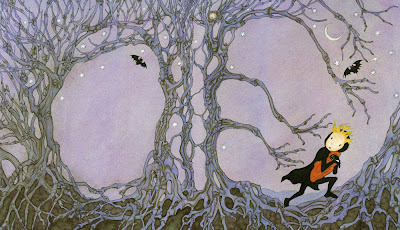
Artwork for the wrap-around cover. The title was originally envisaged to cascade downwards between the branches
As every book is different, I always strive to approach each project with a clean slate, as if it's the first I've ever illustrated. The materials I use are are fairly established, so it's the way I approach the project, my response to the text that determines how the book will take shape. I dislike books where the illustrator slaps the same branded style on whatever manuscript they receive without adapting or exploring to harmonise with the world of the author. I always try to match my work to the tone of the text. Nevertheless, in terms of production technique I do have an established process for creating books and Halloween Forest is quite a typical example of this.
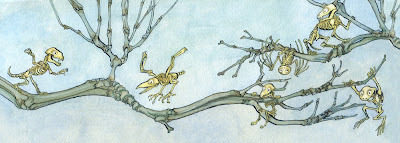
detail from page 16-17
In the case of a picture book written by another writer (as opposed to my own composition) the very first impressions are crucial, often the emotional impact of the first reading can form the germ of the final illustration. It's important to get these ideas down on paper immediately, so before I began reading Marion Dane Bauer's text I made sure I had pen and pencil at hand for jotting. As I read, I noted page breaks (i.e. the natural point where text will roll onto the next page), and jotted down any ideas that immediately came to mind in tiny thumbnail shorthand on the same sheet, like so:
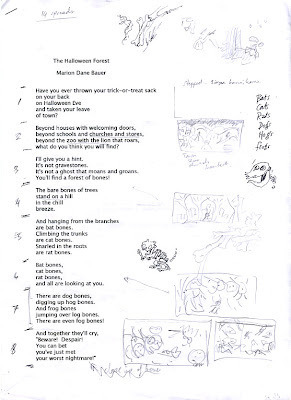
Raw text as received, with my initial notes
Deciding page breaks with Halloween Forest was quite straightforward because the book is in verse, each stanza roughly equated to either one page or one spread (double page) of the book.
Thumbnail jottings helped to establish some of the initial rough look of spreads. I have a
cinematic way of planning images, I imagine the scene as if it were a
stage, then consider a variety of poses or designs to find the
best "camera angle", lighting etc. Often a very elaborate illustration can grow from a tiny compositional note. I then turned to doodling in a sketch pad in pen to explore details suggested by the story, the look of the central character, and some of the visual conundrums created by the text, such as how to visualise a forest of bones.
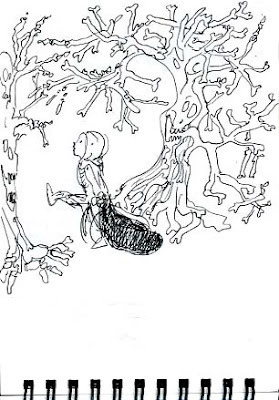
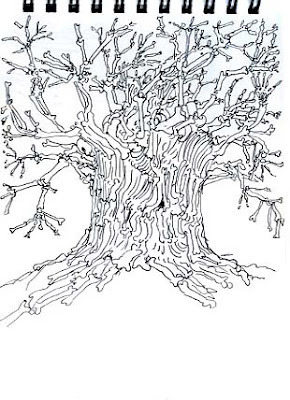
sketchbook doodled ideas
With some ideas thus loosely established, I then started planning the book spreads by using a storyboard such as this, still keeping everything very rough and fluid:
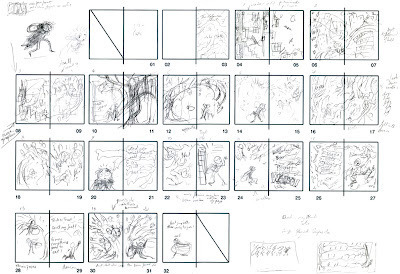
32-page storyboard before starting on sketches
Each square represents a double page spread of a 32-page separate ended book (that is, a book that has separate paste-down endpapers). This allows me to plan the whole book out on one sheet, because everything is small and loose I can change things around easily, scrub out, redraw etc, without any major reworking involved. Often I use post-it notes to re-organise page breaks or move ideas around until I'm happy with the overall planning. I had five or six spreads already fixed in my mind, certain 'crescendo' spreads that would provide the foundations, I developed the remaining connecting spreads around them, looking to establish a rhythmic flow of images through the book.
With the basic planning fixed and ideas of the details in sketch books etc, I then began to draw more elaborate images for each picture in pencil on A4 size paper, one sheet representing a double page spread. These sketches, though larger than the thumbnails, are therefore still considerably smaller than the final artwork.
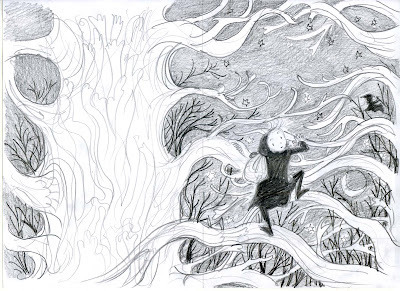
alternative idea for wrap-around cover (unused)
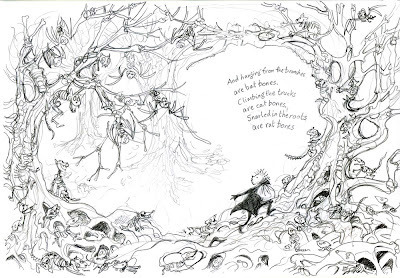
pencil sketch for the spread on pages 12-13
Pencil enables you to easily establish the tone of each picture, some images rely very much on drama created by shadows and highlight. This was a very exciting stage, as the book really began to take form, with details of line, depth and mood established.
Halloween Forest is undeniably a scary story for young children, but at the same time full of fun and rollicking energy. In the illustrations I aimed for a balance between spookiness and humour. The skeleton creatures crawling from the bone forest had to be convincing, but also attractive as characters. I was trying to create a warm glow of acceptable Halloween fright in the reader, finding the right level between scary but not truely frightening was a delicate challenge.
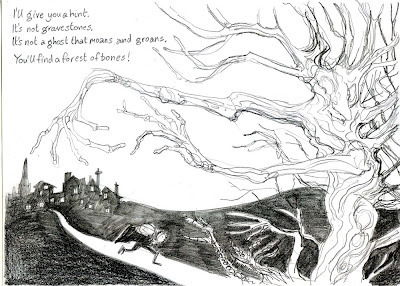
From the town to the forest, sketch for spread on pages 8-9
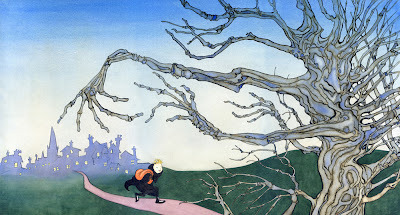
finished art for spread on pages 8-9
Once the whole book was drawn out I scanned each sketch, then in Photoshop and In Design darkened the lines, tweaked proportions, added text where necessary, and emailed the whole dummy book to the art director as a pdf file. The publishers are in America, I was in rural England, but we could have been next door to each other, ah! the wonders of technology. There were a few editorial revisions, most importantly to the last climactic pages, where it was felt there needed to be a house at the heart of the forest as the character is going trick-or-treating. So I dropped one image, adapted and brought another forward one page, and drew a new final spread of a house for page 30-31 (more on which below). Thereafter the book was given approval and I could begin on the final artwork.
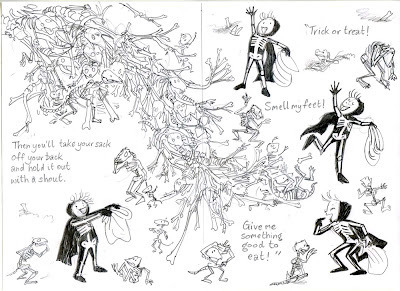
cancelled image - this sketch was dropped and text rearranged so I could fit in a house spread at the end of the book
Using a photocopier, I enlarged copies of the sketches to the final size of the book. Often I work at 115% or 120%, that is to say the artwork is slightly larger than reproduction size of the book, which helps to sharpen definition of detail when it's reduced for printing. The full sized photocopies were then traced in pencil onto watercolour paper using a light box. Finally I was ready to begin inking and painting the illustrations.
Halloween Forest was a very intuitive book which flowed very smoothly, the drawings were straight out of my imagination with very little research, however for reference and to give me a real feel for the subject I looked at a lot of photos of animal bones, which were a great inspiration as well as providing direct reference, though I don't claim that every skeleton is anatomically correct!
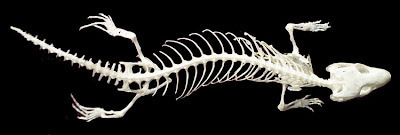
Many of the characters were a balance between visual accuracy, fluidity of image, and animated character.
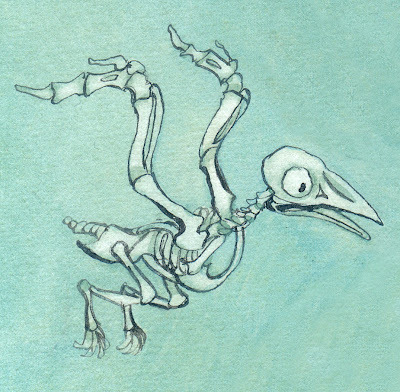
Detail from page 22, I foolishly drew this little bird right across the trim so it was unfortunately cropped in the printed book!
Not every spread is of the forest and bones. At key points of drama I included colourful graphic images designed to jolt the reader and emphasise a turn in the narrative, in these spreads in particular I could play with font layout. As the text was laid out by the designer I gave directions in the sketches as to how I envisaged the words should appear, the design team did a wonderful job in following through with this.
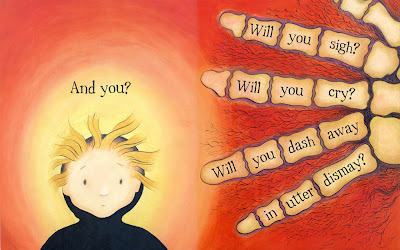
spread on pages 20-21 from the printed book
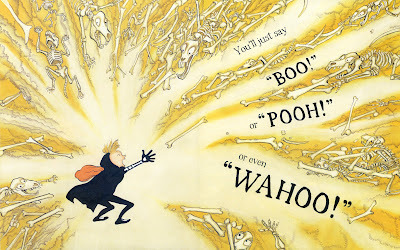
ditto, pages 24-25
Finally, to show the progression of a single illustration here's a series of images of the last climatic spread on page 30-31 in the process of creation.
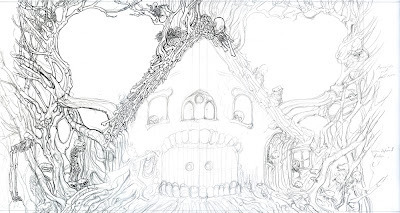
part way through inking with india ink
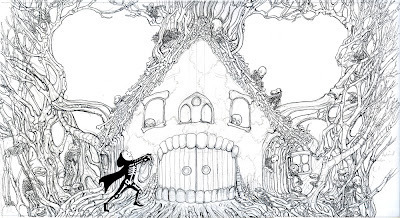
completed pen and ink drawing before colouring
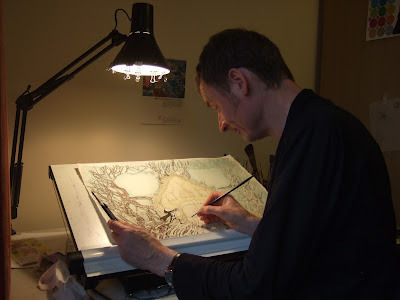
at work on watercolour
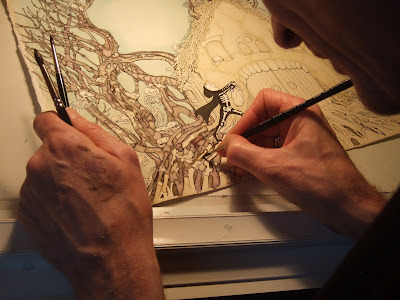
Individual sections of tree were back-filled in two colours and water, which is why I'm holding multiple brushes.
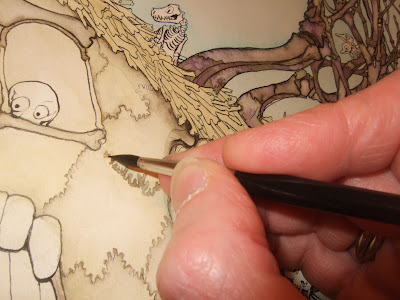
defining sepia edges on the skull house
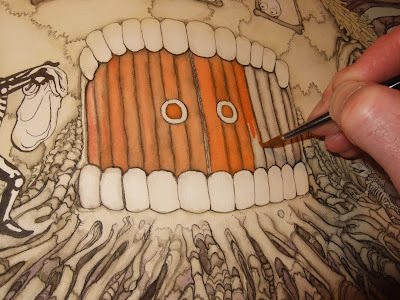
filling in the door
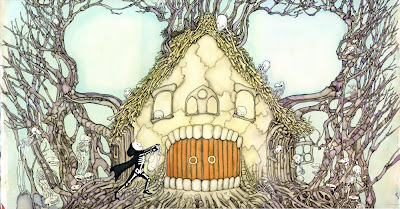
The painting in watercolour almost there
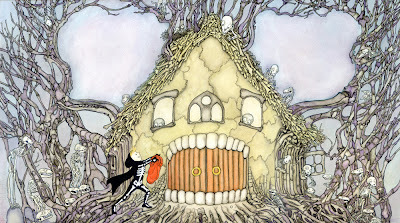
And finally, voila! The completed illustration.


Artwork for the wrap-around cover. The title was originally envisaged to cascade downwards between the branches
As every book is different, I always strive to approach each project with a clean slate, as if it's the first I've ever illustrated. The materials I use are are fairly established, so it's the way I approach the project, my response to the text that determines how the book will take shape. I dislike books where the illustrator slaps the same branded style on whatever manuscript they receive without adapting or exploring to harmonise with the world of the author. I always try to match my work to the tone of the text. Nevertheless, in terms of production technique I do have an established process for creating books and Halloween Forest is quite a typical example of this.

detail from page 16-17
In the case of a picture book written by another writer (as opposed to my own composition) the very first impressions are crucial, often the emotional impact of the first reading can form the germ of the final illustration. It's important to get these ideas down on paper immediately, so before I began reading Marion Dane Bauer's text I made sure I had pen and pencil at hand for jotting. As I read, I noted page breaks (i.e. the natural point where text will roll onto the next page), and jotted down any ideas that immediately came to mind in tiny thumbnail shorthand on the same sheet, like so:

Raw text as received, with my initial notes
Deciding page breaks with Halloween Forest was quite straightforward because the book is in verse, each stanza roughly equated to either one page or one spread (double page) of the book.
Thumbnail jottings helped to establish some of the initial rough look of spreads. I have a
cinematic way of planning images, I imagine the scene as if it were a
stage, then consider a variety of poses or designs to find the
best "camera angle", lighting etc. Often a very elaborate illustration can grow from a tiny compositional note. I then turned to doodling in a sketch pad in pen to explore details suggested by the story, the look of the central character, and some of the visual conundrums created by the text, such as how to visualise a forest of bones.


sketchbook doodled ideas
With some ideas thus loosely established, I then started planning the book spreads by using a storyboard such as this, still keeping everything very rough and fluid:

32-page storyboard before starting on sketches
Each square represents a double page spread of a 32-page separate ended book (that is, a book that has separate paste-down endpapers). This allows me to plan the whole book out on one sheet, because everything is small and loose I can change things around easily, scrub out, redraw etc, without any major reworking involved. Often I use post-it notes to re-organise page breaks or move ideas around until I'm happy with the overall planning. I had five or six spreads already fixed in my mind, certain 'crescendo' spreads that would provide the foundations, I developed the remaining connecting spreads around them, looking to establish a rhythmic flow of images through the book.
With the basic planning fixed and ideas of the details in sketch books etc, I then began to draw more elaborate images for each picture in pencil on A4 size paper, one sheet representing a double page spread. These sketches, though larger than the thumbnails, are therefore still considerably smaller than the final artwork.

alternative idea for wrap-around cover (unused)

pencil sketch for the spread on pages 12-13
Pencil enables you to easily establish the tone of each picture, some images rely very much on drama created by shadows and highlight. This was a very exciting stage, as the book really began to take form, with details of line, depth and mood established.
Halloween Forest is undeniably a scary story for young children, but at the same time full of fun and rollicking energy. In the illustrations I aimed for a balance between spookiness and humour. The skeleton creatures crawling from the bone forest had to be convincing, but also attractive as characters. I was trying to create a warm glow of acceptable Halloween fright in the reader, finding the right level between scary but not truely frightening was a delicate challenge.

From the town to the forest, sketch for spread on pages 8-9

finished art for spread on pages 8-9
Once the whole book was drawn out I scanned each sketch, then in Photoshop and In Design darkened the lines, tweaked proportions, added text where necessary, and emailed the whole dummy book to the art director as a pdf file. The publishers are in America, I was in rural England, but we could have been next door to each other, ah! the wonders of technology. There were a few editorial revisions, most importantly to the last climactic pages, where it was felt there needed to be a house at the heart of the forest as the character is going trick-or-treating. So I dropped one image, adapted and brought another forward one page, and drew a new final spread of a house for page 30-31 (more on which below). Thereafter the book was given approval and I could begin on the final artwork.

cancelled image - this sketch was dropped and text rearranged so I could fit in a house spread at the end of the book
Using a photocopier, I enlarged copies of the sketches to the final size of the book. Often I work at 115% or 120%, that is to say the artwork is slightly larger than reproduction size of the book, which helps to sharpen definition of detail when it's reduced for printing. The full sized photocopies were then traced in pencil onto watercolour paper using a light box. Finally I was ready to begin inking and painting the illustrations.
Halloween Forest was a very intuitive book which flowed very smoothly, the drawings were straight out of my imagination with very little research, however for reference and to give me a real feel for the subject I looked at a lot of photos of animal bones, which were a great inspiration as well as providing direct reference, though I don't claim that every skeleton is anatomically correct!

Many of the characters were a balance between visual accuracy, fluidity of image, and animated character.

Detail from page 22, I foolishly drew this little bird right across the trim so it was unfortunately cropped in the printed book!
Not every spread is of the forest and bones. At key points of drama I included colourful graphic images designed to jolt the reader and emphasise a turn in the narrative, in these spreads in particular I could play with font layout. As the text was laid out by the designer I gave directions in the sketches as to how I envisaged the words should appear, the design team did a wonderful job in following through with this.

spread on pages 20-21 from the printed book

ditto, pages 24-25
Finally, to show the progression of a single illustration here's a series of images of the last climatic spread on page 30-31 in the process of creation.

part way through inking with india ink

completed pen and ink drawing before colouring

at work on watercolour

Individual sections of tree were back-filled in two colours and water, which is why I'm holding multiple brushes.

defining sepia edges on the skull house

filling in the door

The painting in watercolour almost there

And finally, voila! The completed illustration.
Published on October 03, 2012 07:09
October 1, 2012
Halloween Forest on general release!
At last it's out! Scheduled for July, but postponed until the Autumn. Now, finally, today, the picture book Halloween Forest is on sale in bookshops across the US and online!
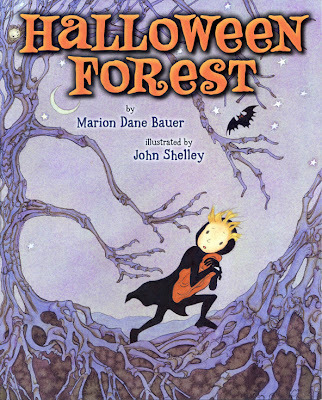
Author Marion Dane Bauer has blogged about the book here.
Publishers Weekly and Kirkus Reviews have also given the book a thumbs up. Starred review no less!
Here's a few images from the book (artwork scans before text)
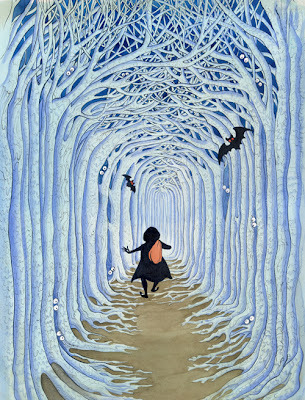
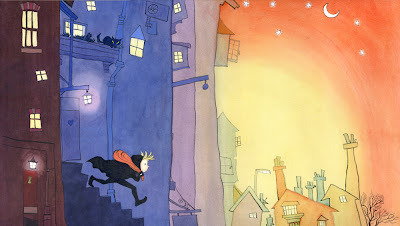
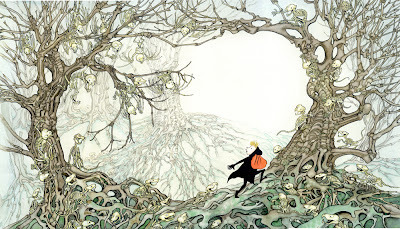
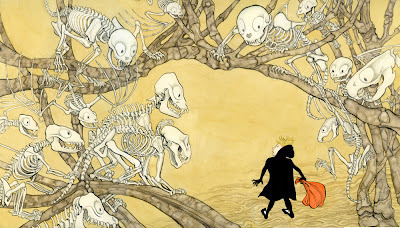
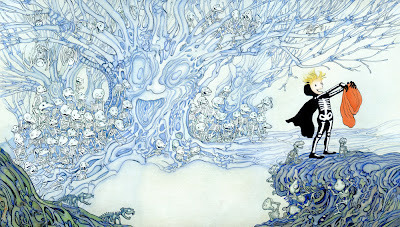
I'll talk about some of the processes involved in creating the illustrations in my next post.

Author Marion Dane Bauer has blogged about the book here.
Publishers Weekly and Kirkus Reviews have also given the book a thumbs up. Starred review no less!
Here's a few images from the book (artwork scans before text)





I'll talk about some of the processes involved in creating the illustrations in my next post.
Published on October 01, 2012 03:08
September 26, 2012
Autumn in the Air
Published on September 26, 2012 04:23
September 19, 2012
Jack and the Beanstalk
My latest book!
Published by Fukuinkan Shoten on 10th September in Japan, ジャックと豆の木 (Jack to Mame no Ki) is a 44 page picture book, re-told and illustrated by yours truly from the traditional tale, translated by Yuko Obika.
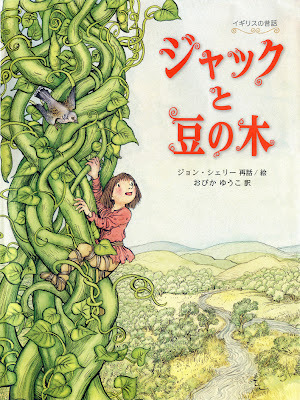
The book can be ordered online from overseas via Amazon Japan.
Published by Fukuinkan Shoten on 10th September in Japan, ジャックと豆の木 (Jack to Mame no Ki) is a 44 page picture book, re-told and illustrated by yours truly from the traditional tale, translated by Yuko Obika.

The book can be ordered online from overseas via Amazon Japan.
Published on September 19, 2012 01:00
September 18, 2012
Tokyo Wrap Up
I'm finally back home after a successful show at Space Yui in Tokyo.
Japan was wonderful for both daughter and myself, though it was very much a 'working holiday' for me. For the first month I was largely focused on meeting deadlines, producing work for the show and other such business, so not so many opportunities for socialising and enjoying the summer break. However the hard work was all worthwhile in the end, the exhibition at Space Yui was a tremendous success. My deepest thanks to Kimura-san and all the other staff at the gallery.
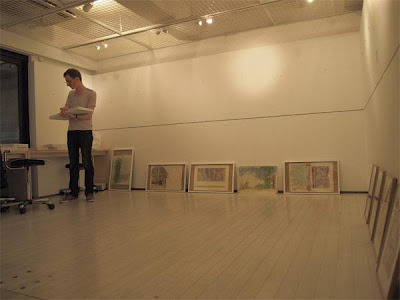
Setting up the show in the gallery (photo courtesy of Space Yui)
In addition to the artwork from 'Jack to Mame no Ki', limited edition prints and the original images drawn for the show, Space Yui also produced some T-Shirts from the unfinished artwork to my next book The Stone Giant. Although the artwork is yet to be painted in colour I had some scans of the ink drawings in black and white stage, which were perfect for the T-Shirt and made a very big impact on the show attendees.
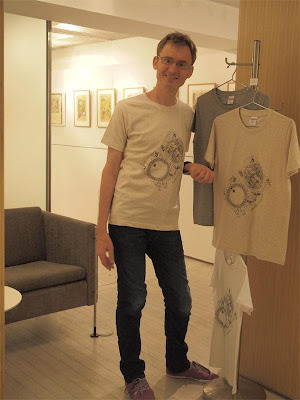
In Space Yui Gallery modelling the t-shirts produced for the show
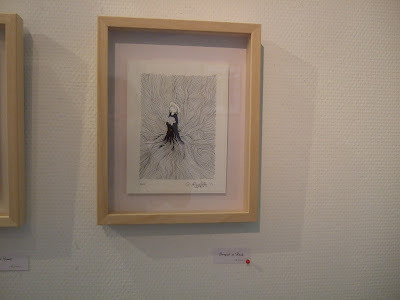
One of the numerous drawings developed from sketchbook images sold during the show
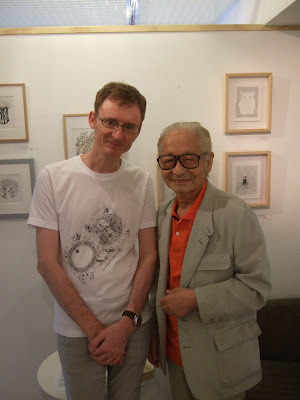
Legendary zoologist, TV personality and author Mutsugoro (Masanori Hata)
I didn't take many photos, but I've posted a very few snapshots of the attendees and more of the displayed work on my Facebook feed
Finally the exhibition was over and daughter and I were able to finally relax. Straight after the exhibition we were invited by my editors at Fukuinkan to the Nagano mountains to stay in a Besso (country cottage) and research our next book. It was a wonderful tonic after the stifling heat of Tokyo!
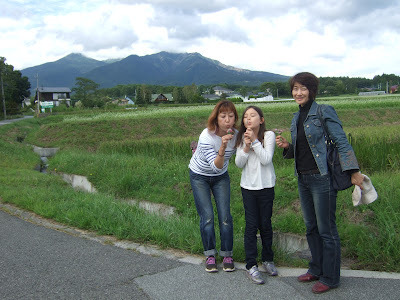
Seren in Kobuchizawa with Roa and Yuriko
Finally back in Tokyo I was just in time to enjoy the release of Jack to Mame no Ki on 10th September!
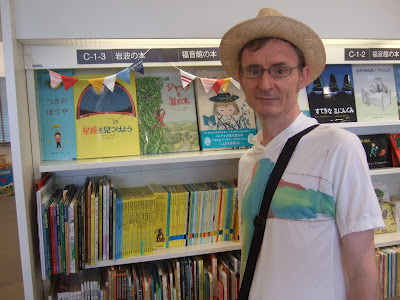
Fukuinkan section in the Tama Plaza branch of Yurindo Bookshop. Jack gets centre stage!

Japan was wonderful for both daughter and myself, though it was very much a 'working holiday' for me. For the first month I was largely focused on meeting deadlines, producing work for the show and other such business, so not so many opportunities for socialising and enjoying the summer break. However the hard work was all worthwhile in the end, the exhibition at Space Yui was a tremendous success. My deepest thanks to Kimura-san and all the other staff at the gallery.

Setting up the show in the gallery (photo courtesy of Space Yui)
In addition to the artwork from 'Jack to Mame no Ki', limited edition prints and the original images drawn for the show, Space Yui also produced some T-Shirts from the unfinished artwork to my next book The Stone Giant. Although the artwork is yet to be painted in colour I had some scans of the ink drawings in black and white stage, which were perfect for the T-Shirt and made a very big impact on the show attendees.

In Space Yui Gallery modelling the t-shirts produced for the show

One of the numerous drawings developed from sketchbook images sold during the show

Legendary zoologist, TV personality and author Mutsugoro (Masanori Hata)
I didn't take many photos, but I've posted a very few snapshots of the attendees and more of the displayed work on my Facebook feed
Finally the exhibition was over and daughter and I were able to finally relax. Straight after the exhibition we were invited by my editors at Fukuinkan to the Nagano mountains to stay in a Besso (country cottage) and research our next book. It was a wonderful tonic after the stifling heat of Tokyo!

Seren in Kobuchizawa with Roa and Yuriko
Finally back in Tokyo I was just in time to enjoy the release of Jack to Mame no Ki on 10th September!

Fukuinkan section in the Tama Plaza branch of Yurindo Bookshop. Jack gets centre stage!
Published on September 18, 2012 08:33
August 26, 2012
Tokyo Exhibition
Today's the first day of my show in Tokyo, this promises to be an interesting week!
Half the show is focused on my forthcoming picture book "Jack to Mame no Ki" (Jack and the Beanstalk), showing original artwork from the book such as this:
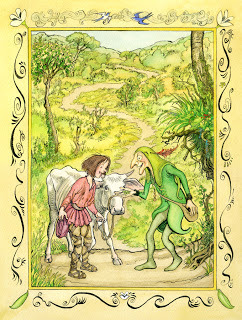
and this:
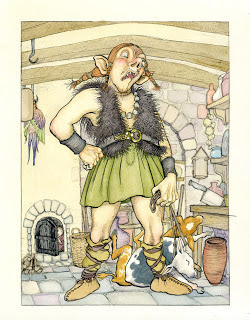
The Gallery has produced some fabulous limited edition prints, these two images from the book, each with a print run of 20, will be available through the Space Yui online shop even after the close of the show.
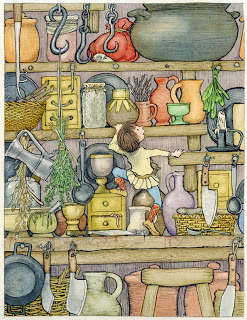
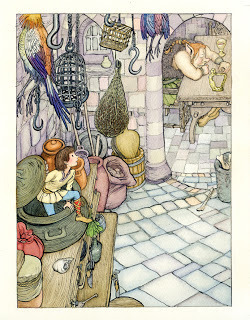
In addition to the book artwork I'm exhibiting two large originals from the Art Print Japan/Disney collaboration, which some may remember I showed on the blog a while back:
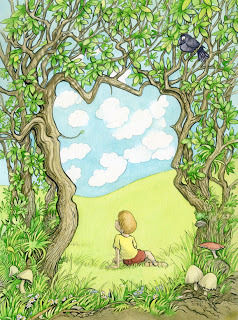
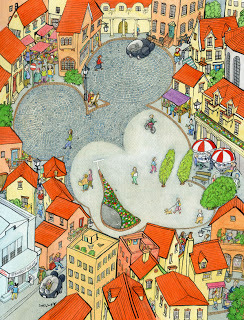
The remainder of the show consists of a profusion of smaller pieces specially created for the exhibition, many of them developed from sketches I've previously posted on the blog, such as these:
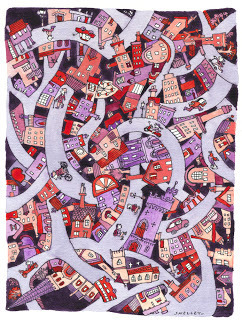
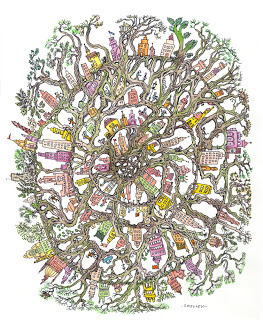
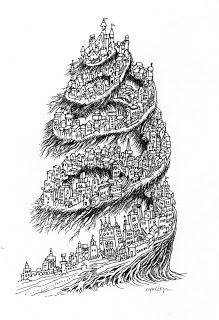
Together with some new drawings like this:
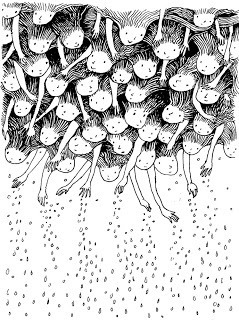
Finally the gallery has also created some T-Shirts from images for my book on Michelangelo's David, which is actually still in production! The T-Shirts and all the images except the 'Jack' artwork are for sale. I'm extremely grateful for all the tremendous support and help given by the dedicated gallery staff.
So there's something for everyone. If you're in Tokyo this week do drop in!
Half the show is focused on my forthcoming picture book "Jack to Mame no Ki" (Jack and the Beanstalk), showing original artwork from the book such as this:

and this:

The Gallery has produced some fabulous limited edition prints, these two images from the book, each with a print run of 20, will be available through the Space Yui online shop even after the close of the show.


In addition to the book artwork I'm exhibiting two large originals from the Art Print Japan/Disney collaboration, which some may remember I showed on the blog a while back:


The remainder of the show consists of a profusion of smaller pieces specially created for the exhibition, many of them developed from sketches I've previously posted on the blog, such as these:



Together with some new drawings like this:

Finally the gallery has also created some T-Shirts from images for my book on Michelangelo's David, which is actually still in production! The T-Shirts and all the images except the 'Jack' artwork are for sale. I'm extremely grateful for all the tremendous support and help given by the dedicated gallery staff.
So there's something for everyone. If you're in Tokyo this week do drop in!
Published on August 26, 2012 17:13
August 17, 2012
Adventures with a Pen
Announcing my Exhibition in Aoyama, Tokyo.
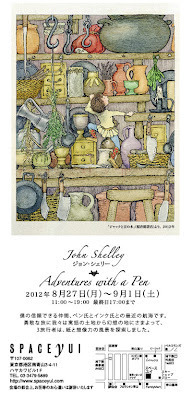
Adventures with a Pen
John Shelley exhibition
27th August-1st September
At Space Yui
http://www.spaceyui.com
(nearest station - Gaienmae)
Recent voyages with my trusty companions, Mr Pen and Mr Ink. On our intrepid journey we wandered from the land of fable to the land of illusion, three travellers across a landscape of paper and imagination.
The show will include illustrations from the forthcoming book ジャックと豆の木 Jack to Mame no Ki (Jack and the Beanstalk), plus original art for sale, T-Shirts and limited edition prints.
I'll be in the gallery from around midday most days. Please drop by and say hello!


Adventures with a Pen
John Shelley exhibition
27th August-1st September
At Space Yui
http://www.spaceyui.com
(nearest station - Gaienmae)
Recent voyages with my trusty companions, Mr Pen and Mr Ink. On our intrepid journey we wandered from the land of fable to the land of illusion, three travellers across a landscape of paper and imagination.
The show will include illustrations from the forthcoming book ジャックと豆の木 Jack to Mame no Ki (Jack and the Beanstalk), plus original art for sale, T-Shirts and limited edition prints.
I'll be in the gallery from around midday most days. Please drop by and say hello!
Published on August 17, 2012 23:09
August 6, 2012
Tokyo Summer
As some may know, I'm back in Tokyo all through the summer, to organise an exhibition (more on that shortly), run a workshop for SCBWI Tokyo on the 19th, see as many old friendly faces as possible, and basically to just re-connect with my former home of 21 years.
It's very good to be back, even though school holidays dictate daughter and I are here at the hottest time of year. Most people here can't understand why I would want to come back here while the Olympics are on in London, and in this heat. Fortunately I love the Japanese summer. There's a unique ambience to the city at this time of year, things slow down, less bussle, more time for contemplation.
Last night I dreamed that Tokyo was like an ice cream slowly melting in the heat. In reality it's not exactly as cool as ice cream.
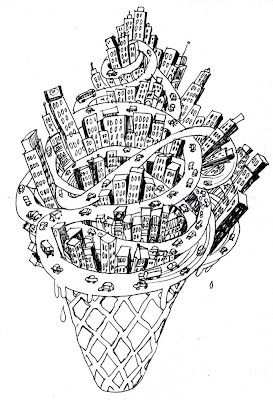
I always have a lot to contemplate when I come back here, most of it connected to the sudden death of my wife in 2007 and subsequent decision to return to the UK. Maki's presence is always with me, but never more so than when I tread the familiar streets of Tokyo. The comfort of familiarity here pulls me back. This still feels like home, it's like an old familiar musical instrument that you can just lose yourself in, make beautiful sounds with. I don't feel the same connection with anywhere in the UK, even after 5 years back there. It's definitely time to move on.
It's been 2 years since I was here last, this has been the longest time away from Japan since I lived here. Some things have changed, superficially the shops in Shibuya and other places, but still it's the same old city. One thing that has surprised me is the invisibility of the Tsunami and Fukushima on Tokyo. Outside the under-reported demos, Tokyo just carries on as it always has, last years' disaster is almost completely invisible. Such stoicism and willingness to "stay calm and carry on " is both reassuring and worrying. People are willing enough to relate their memories of the earthquake, but no-one generally talks about the ongoing problem of Fukushima. There's a sense of resignment, of helpless resentment in the face of challenges. The government has never listened much to the wishes of the people in the past, so the mechanism for effective dissent is underdeveloped, there are plenty of opinions, but most people stay on the wings. There is much talk of the nuclear issue of course, yesterday was the anniversary of Hiroshima, there was much on the TV, some comparisons with Nuclear energy in Japan today. The media is covering the issues to a point.
But generally, life just carries on as it always has. Hot, sultry, vibrant and determined. If Tokyo melts it won't be due to sunshine, despite the mixed emotions and loneliness coming back here I'm enjoying Tokyo immensely, though I am missing the euphoria of the London Olympics a bit. Unless you watch things live (late at night) Japanese TV only shows the progress of Japanese athletes, so I've only seen snippets of the Olympics. Oh well, can't have everything.

It's very good to be back, even though school holidays dictate daughter and I are here at the hottest time of year. Most people here can't understand why I would want to come back here while the Olympics are on in London, and in this heat. Fortunately I love the Japanese summer. There's a unique ambience to the city at this time of year, things slow down, less bussle, more time for contemplation.
Last night I dreamed that Tokyo was like an ice cream slowly melting in the heat. In reality it's not exactly as cool as ice cream.

I always have a lot to contemplate when I come back here, most of it connected to the sudden death of my wife in 2007 and subsequent decision to return to the UK. Maki's presence is always with me, but never more so than when I tread the familiar streets of Tokyo. The comfort of familiarity here pulls me back. This still feels like home, it's like an old familiar musical instrument that you can just lose yourself in, make beautiful sounds with. I don't feel the same connection with anywhere in the UK, even after 5 years back there. It's definitely time to move on.
It's been 2 years since I was here last, this has been the longest time away from Japan since I lived here. Some things have changed, superficially the shops in Shibuya and other places, but still it's the same old city. One thing that has surprised me is the invisibility of the Tsunami and Fukushima on Tokyo. Outside the under-reported demos, Tokyo just carries on as it always has, last years' disaster is almost completely invisible. Such stoicism and willingness to "stay calm and carry on " is both reassuring and worrying. People are willing enough to relate their memories of the earthquake, but no-one generally talks about the ongoing problem of Fukushima. There's a sense of resignment, of helpless resentment in the face of challenges. The government has never listened much to the wishes of the people in the past, so the mechanism for effective dissent is underdeveloped, there are plenty of opinions, but most people stay on the wings. There is much talk of the nuclear issue of course, yesterday was the anniversary of Hiroshima, there was much on the TV, some comparisons with Nuclear energy in Japan today. The media is covering the issues to a point.
But generally, life just carries on as it always has. Hot, sultry, vibrant and determined. If Tokyo melts it won't be due to sunshine, despite the mixed emotions and loneliness coming back here I'm enjoying Tokyo immensely, though I am missing the euphoria of the London Olympics a bit. Unless you watch things live (late at night) Japanese TV only shows the progress of Japanese athletes, so I've only seen snippets of the Olympics. Oh well, can't have everything.
Published on August 06, 2012 19:06
July 23, 2012
Michelangelo in Monochrome
Things are so hectic right now I can hardly stop to think. Daughter and I have just moved house, and before we have a chance to unpack we'll be off to Japan for the rest of the summer where I'll be exhibiting and running a workshop. Nevertheless I've just time to post a few images of work-in-progress from my current project, a non-fiction picture book by Jane Sutcliffe, The Stone Giant, the story of Michelangelo's creation of the statue of David, which will be published by Charlesbridge in the United States sometime, erm..... after I've finished! The house move and Tokyo trip have inevitably put things on hold for the moment, but I've completed all the pen-and-ink line work and will get straight into painting watercolour when we get back from Tokyo.
So here's a sneak preview at the black and white stage!
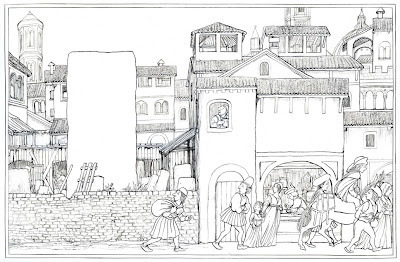
Naturally a lot of research was necessary (and boy did I love that!), and in some cases a degree of estimation. I hope the results are not too far off the mark.
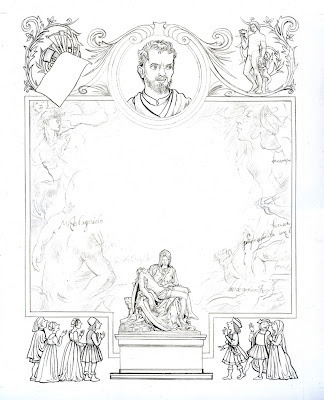
I'm trying to steer a path between imagination and historical accuracy, a
flavour of the period, and a flavour of me so to speak.
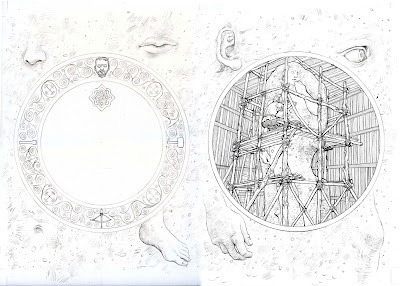
The final spread showing a panorama of the Piazza Signoria from the Palazzo Vecchio. There are no historical images from this angle that I know of and none of these buildings exist now, so a lot of detective work was required to estimate the architecture of the square in the Renaissance. Fingers crossed the experts will be happy!
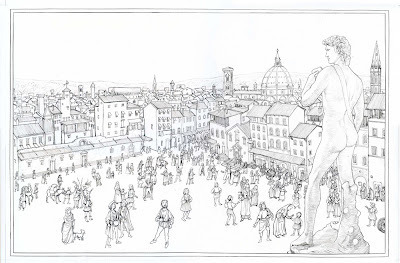

So here's a sneak preview at the black and white stage!

Naturally a lot of research was necessary (and boy did I love that!), and in some cases a degree of estimation. I hope the results are not too far off the mark.

I'm trying to steer a path between imagination and historical accuracy, a
flavour of the period, and a flavour of me so to speak.

The final spread showing a panorama of the Piazza Signoria from the Palazzo Vecchio. There are no historical images from this angle that I know of and none of these buildings exist now, so a lot of detective work was required to estimate the architecture of the square in the Renaissance. Fingers crossed the experts will be happy!

Published on July 23, 2012 02:00

